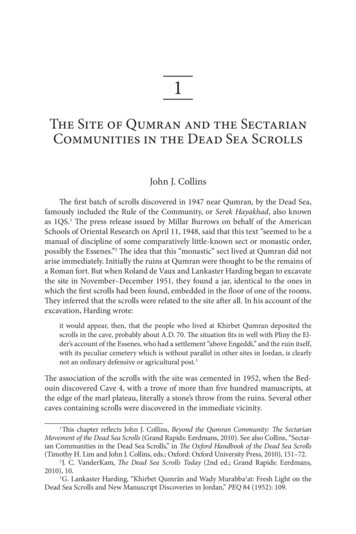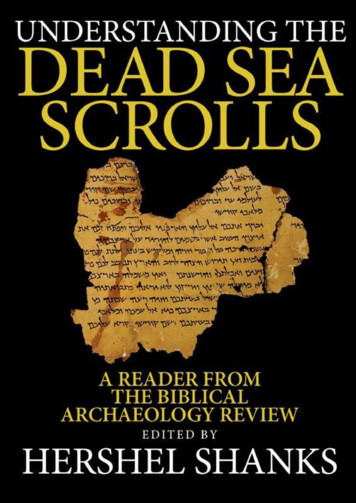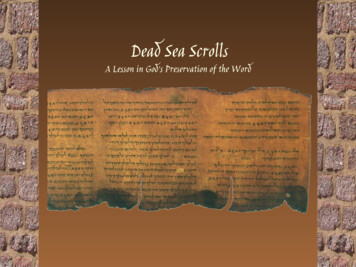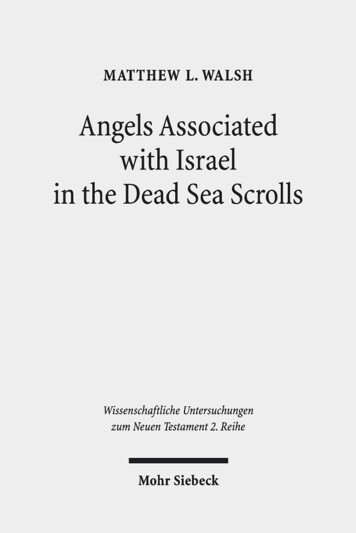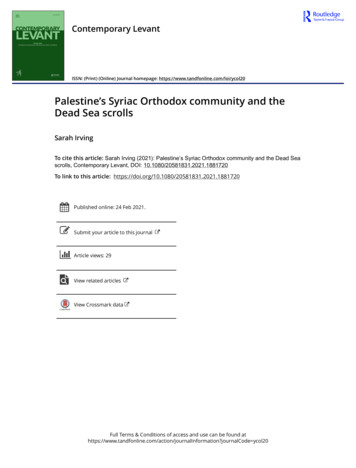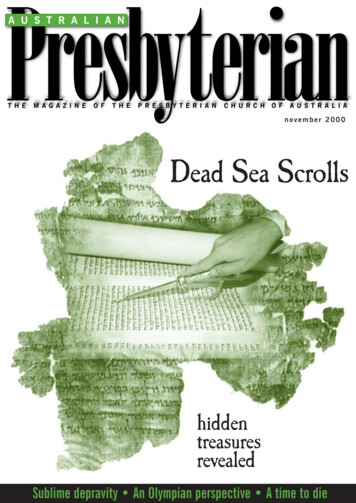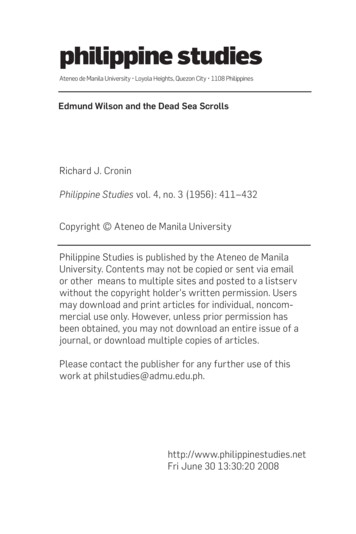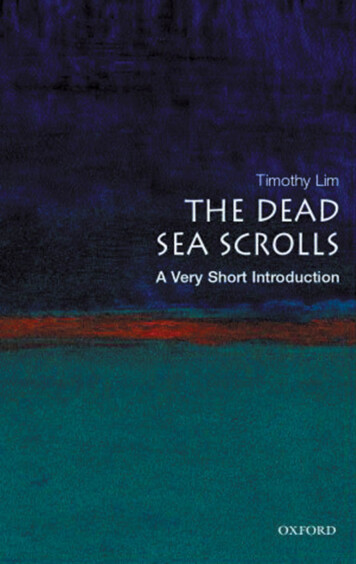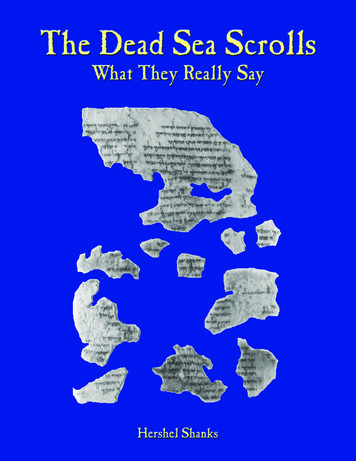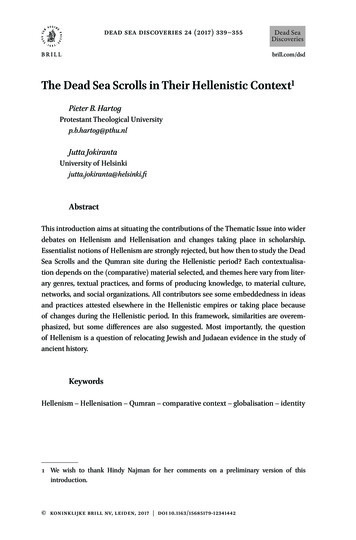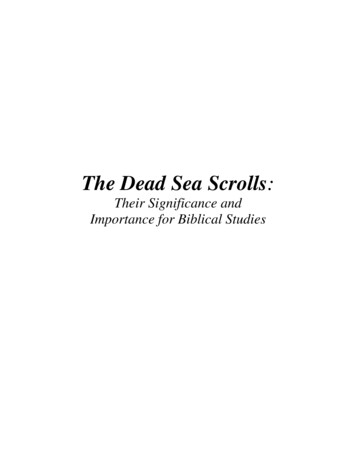
Transcription
Dead Sea Scrolls - TheMusic of the BibleAn overview on the work of Suzanne Haik-Vantura(1912 2000)Hebrew Bible CantillationITU-State Conservatory, Istanbul. Term ProjectMehmet OkonşarJanuary 27, 2011i
ContentsBiblical researchBiblical Exegesis . . . . . . . . . . . . . . . . . . . . . . . . . . . .Traditional Judaic Bible Studies . . . . . . . . . . . . . . . . . . .112Musical Archeology”New Testament” Times . . . . . . . . . . . . . . . . . . . . . . . .Incantation versus Chanting . . . . . . . . . . . . . . . . . . . . . .223Dead Sea ScrollsThe discovery . . . . . . . . . . . . . . . . . . . . . . . . . . . . . .The importance of the Scrolls . . . . . . . . . . . . . . . . . . . . .Qumran-Essene Theory and the departures from it . . . . . . . . .4678The textsGrouping the Scrolls . . . . . . . . . . . . . . . . . . . . . . . . . .Excavations . . . . . . . . . . . . . . . . . . . . . . . . . . . . . . .91011The Story of the DiscoveryThe Bedouins . . . . . . . . . . . . . . . .Mar Samuel . . . . . . . . . . . . . . . . .The photographies allows for the readingGetting into the right hands . . . . . . . .Historical importance of the Scrolls . . . .Facts About the Dead Sea Scrols . . . . .11111212131314.On Jewish Liturgical Music17Maqams18Cantillation SignsThe Purpose of Cantillation SignsThe syntactical function . . . . . .Importance in the understanding .The phonetic function . . . . . . .The musical function . . . . . . . .192020212222Types of CantillationBabylonian system .Palestinian system .Tiberian system . .Differentiation in the.2222232425Marks. . . . . . . . . . . . . . . . . . . . . .poetic booksNotation25ii
Suzanne Haik-Vantura26The MethodologyThe schools of interpretation of the signs. . . . . . . . . . . . . .2828Appendices30Names and Meaning of the Signs . . . . . . . . . . . . . . . . . . . 30Sequences . . . . . . . . . . . . . . . . . . . . . . . . . . . . . . . . 31Groups . . . . . . . . . . . . . . . . . . . . . . . . . . . . . . . . . 32List of Figures123456789101112Silver lyre . . . . . . . . . . . . . . . .The Qumran cavern . . . . . . . . . .Qumran living quaters of the EssenitesQumran chronology . . . . . . . . . .Cavern n.4 . . . . . . . . . . . . . . .for sale . . . . . . . . . . . . . . . . . .The Torah scroll . . . . . . . . . . . .Cantillation signs, 1 . . . . . . . . . .Cantillation signs, 2 . . . . . . . . . .Cantillation signs, 3 . . . . . . . . . .Suzanne Haik-Vantura . . . . . . . . .Cantillation signs . . . . . . . . . . . .iii.378101113151919202729
AbstractThis paper investigates on the cantillation marks found in the DeadSea Scrolls. Their reconstruction by the French musicologist SuzanneHaik-Vantura.iv
Biblical researchBiblical research is the academic investigation of the Judeo-ChristianBible along with related texts.For Christianity, the Bible usually consists the New Testament and OldTestament, who together are often called the “Scriptures.”Judaism recognizes as scripture only the Hebrew Bible, commonly knownas as the Tanakh. Other texts generally examined by biblical scholars are theJewish apocrypha , the Jewish pseudo-epigrapha, the Christian apocrypha,the numerous kinds of ante-Nicene early Christian literature, as well as earlyJewish literature.Biblical studies is actually a department associated with theology butan extremely technical and diversified area, it brings on the particular disciplines involving history, literary criticism, philology, and progressively morethe social sciences.Professionals connected with Biblical Research do not really possess religious beliefs commitment to the texts they examine. One other approachis the study with the Bible being a religious text, in which the assumption isthat the Bible carries a divine source or inspiration. This method is really abranch associated with theology, and is also known as Biblical interpretation.Bible believers often are faced with the charge that the Bible is filledwith faults. These alleged mistakes can be placed inside two main groups:obvious inside inconsistencies amongst revealed data; and also scribed errorswithin the actual underlying manuscripts on their own.Biblical ExegesisIn Christianity, the actual theological interpretation of Biblical passagesis known as biblical exegesis. Other divisions of Bible study purpose ratherat elucidating the sources, authorship, and chronological classification ofBiblical texts.This is a department associated with philology much more than theology,and occasionally comes in to conflict with theology. “Higher criticism” andits conclusions, including the well identified documentary hypothesis whichindicates that the Bible has been compiled from the writings of several different scribes, and also the work associated with the Jesus Seminar, thatattempted to be able to cull “inauthentic” sayings of Jesus from the actual“genuine” ones included in the Gospels, are good examples of Biblical studieswhose results have been especially questionable within theology.1
Traditional Judaic Bible StudiesIn Judaism, especially among the Orthodox, traditional Bible study entails the actual research of Tanakh along with medieval as well as modernrabbinic commentaries or with Midrashim, which traditionally have adoptedthe actual Biblical interpretation or exegesis approach. Jews typically studyin the household or in institutions such as the yeshiva.Musical ArcheologyWhen working with the particular Dead Sea Scrolls we are coping witha period while writing itself was new.Cuneiform tablets remain from early Old Testament-Ancient Near Easttimes, hieroglyphs, and down the line Hebrew scripting. Papyrus was basically new.”New Testament” TimesIn New Testament times, the particular Greek and also Roman alphabetshave been in use, but higher mathematics still were unavailable until thediscovery of Arabic numerals.The actual crudest form of musical notation needed to wait around todevelop another thousand years after New Testament times, resulting in1600 years, to refine it to contemporary understanding.So how can we discover songs of these times? Merely by referrals to thatancient materials and also to the effective oralverbal custom by itself, andalso organology, and archaeology, as well as the mixed skills of specialistpaelaeography and ethnomusicology.We have been especially indebted on the huge scholarship of Jewish musicologist Abraham Idelsohn, working in the first years of the 20th centuryto create his monumental Thesaurus of Hebrew Oriental Songs.Idelsohns’s researches in Jewish neighborhoods throughout the world,and especially the Babylonian Jews, offered him recurring motives as well asprogressions that have been not really apparent in almost any other nationalnor ethnic music, suggesting a common origin with regard to these melodieswithin Israel/Palestine of the first century CE before the destruction of theSecond Temple.These types of musical pieces fell in to three tonal centres: Dorian, Phrygian and Lydian modes of the old Greeks (by itself suggesting a standardear in the region).Church music for millenia was based about these types of modes, andgrew to become called the Ecclesiastical Modes - virtually all named after numerous Greek tribes. Dorian (D-d), Phrygian (E-e ), Lydian (F-f), Mixolydian (G-g), Aeolian (A-a), Ionian (C-c) - (note B-b is actually missing- a2
Figure 1: Silver lyredropped Locrian mode).They are distant from your modern day Major/minor modes. But because these are oriental melodies, there are also microtones, quartertones,that is usually, in between each note of those modes. The octave consistsof twenty-four quartertones, not necessarily twelve semitones as we all areused to.Incantation versus ChantingIt is likely that this vocal music coming has been neither chanted norsung to the modern ears accustomed to developed voices, but declamed orperhaps incanted in a probably nasal tone, with a tight throat, not dissimilarto Polynesian or Maori singing production.This is the Latin expression “carmen dicere” to communicate the melodythat continues like a Middle eastern and also Jewish custom. It enables thesinger to breathe the lyrics of the prophets, and also have the meaning at aprofound level, and also connect awareness with the prophets.Some sort of gilded lyre discovered at Ur-c2650BCE, testifies to a sophisticated music concept and procedure right now there, which includesa wealth of contemporary Akkadian cuneiform texts about tuning settings,string names and also hymns.These individuals were mindful of their pantheon of gods inhabiting theparticular world of music. So a intonation system for a stringed musicalinstrument, possibly this lyre, uses “Gotterzahlen” - God-Numbers, possiblythroughout an attempt to resonate with the god.3
In some sort of musico-mythographical context, these god-numbers orratios, tend to be expressed within systems, tantalisingly for us, sometimesfrequencies as well as units regarding string length, or even both equally,symbolizing the various gods Anu, Enlil, Sin, Samas, Bel, Mardu (15 - 30 40 - 50 - 60) (in this are evident octaves and Pythagorean ratios that grewto become the foundation of Western tuning methods).This can imply they had music in two parts, the particular lowest string(15) giving the bass line or drone. It could even imply a method of harmonybased on chords of some type - such did not begin to evolve within WesternMusic until eventually medieval periods.Dead Sea ScrollsThe Dead Sea Scrolls were initially discovered from Bedouin herders afterwhich by archaeologists close to Khirbet Qumran, on the northwestern coastline of the Dead Sea in Israel. A large number of pieces had been discoveredand put together into more than 900 distinct documents including biblicalbooks, hymns, prayers, and other important writings. Dead Sea scrollshappen to be called the biggest manuscript breakthrough discovery of recentyears.The geography of the discovery is a dry region 20km Eastern of Jerusalemand 450m below sea level. Dead Sea Scrolls are comprised of the remains ofapproximately 825 to 870 individual scrolls, represented by tens of thousandsof fragments.The manuscripts are most commonly manufactured from animal skins,but additionally papyrus and one made of copper. They are generally made4
5
with a carbon-based ink, from right to left, using no puctuation marks exceptfor an occasional paragraph formatting.The discoveryMuhammed edh-Dhib along with his nephew discovered the caves, andsoon afterwards the scrolls. John C. Trever reconstructed the story of thescrolls by many interviews with the Bedouin. edh-Dhib’s cousin noticed thecaves, however edh-Dhib on his own has been the first to really fall into one.He retrieved a small number of scrolls, which Trever recognizes as beingthe Isaiah Scroll, Habakkuk Commentary, as well as the Community Rule(initially known as “Manual of Discipline”), and took them back into thecamping to show to his family. None from the scrolls had been damaged onthis course of action, in spite of common rumor.The Dead Sea Scrolls appear to be the particular library of a Jewishsect, deemed more than likely the Essenes. Close to the caves are the historicruins of Qumran, there is one village excavated during the early 1950’s whichexhibits connections both the Essenes and also the scrolls.Qumran is a good archaeological site in the West Bank. It is situatedupon one dry plateau roughly a mile away from the coast from the northwestern shore of the Dead Sea, near the Israeli settlement deal and kibbutzof Kalia.The Essenes had been strictly observant Jewish scribes, who appear Messianic as well as apocalyptic in believing. The library appears to have endedup concealed away within caverns around the outbreak of the initial JewishRevolt (66-70 A.D.) when the Roman military progressed while combatingthe Jews.Whatever may be the beginnings of these scrolls, their importance continues to be irrefutable. People see it through numerous points of views andtry to draw meanings from it.6
Figure 2: The Qumran cavernThe importance of the ScrollsWith regard to Hebrew literature, it is an important piece pertaining totextual research. Similarly when it comes to the experts in paleography itis really an opportunity for studying the particular versions within Hebrewwriting styles. For students of Judaism, the scrolls shed light on the actualtendencies on existence while in the Jewish revolt and to the advocatesof Christianity certainly , there tend to be evidences within the messianicprophecy.The the greater part of the scrolls are housed in Israel under the attentionas well as guardianship of the Israel Antiquities Authority (eight manuscriptsat the Shrine of the Book museum together with all others in the IAA StateCollections). Additionally, there are a few scrolls inside Jordan as well as inEurope.Exactly why have been the scrolls concealed in the caves? Exactly whoput these there? Found in 1952, Cave four generated the largest find. About15,000 fragments coming from over 500 manuscripts were found. In cavesoverlooking the Dead Sea, where the Essenes are believed to have dwelled,scrolls were stored which were to get discovered within the 20th century.Thirty-three of the scrolls appeared to be in Hebrew, which usually, in thetimes of the Essenes, has been regarded as the holy language of Moses.First and foremost, there was the challenging task involving deciphering aswell as translating, through photos, the manuscripts from Qumran CavernFour that had previously remained unpublished. Another aspect featuresinvestigate the overall problem of identification of the authors of the scrolls7
Figure 3: Qumran living quaters of the Essenitesand, progressively, to look at the essentials of the Khirbet Qumran site andthe theory the manuscripts found at the surrounding caverns were composedby the sect ostensibly living there.Qumran-Essene Theory and the departures from itThe Qumran-Essene theory continues to be the particular dominant theory since its preliminary proposal by Roland de Vaux and J.T. Milik. Recently, nonetheless, several other scholars already have suggested substituteorigins for the scrolls. The main point of departure from the QumranEssene theory is actually doubt to link the Dead Sea Scrolls especially withthe Essenes. Most advocates of the Qumran-Sectarian concept understanda group of Jews residing in or near Qumran being responsible for the DeadSea Scrolls, but do not necessarily deduce that the sectarians usually areEssenes.Qumran-Sadducean Theory: A specific alternative on the QumranSectarian theory which has acquired a lot current recognition, is actuallythe effort of Lawrence H. Schiffman who proposes that this community hadbeen directed by a group of Zadokite priests (Sadducees). Probably themost essential document supporting this view would be the “Miqsat Ma’ase8
Ha-Torah” (4QMMT), which points out purity regulations (such as the shiftof impurities) just like those attributed in rabbinic documents to the Sadducees. Scroll 4QMMT additionally reproduces a festivity calendar thatfollows Sadducee principles with regard to the actual dating of certain festival days.Christian Origin Theory: Although one can find undoubtedly someprevalent features shared in between different Jewish sectarian groups, themajority of historians deny there is any kind of link among the Christians andthe writers of the Dead Sea Scrolls. There is certainly little to claim that theChristians at the moment had been as secluded or even as interested in elaborate traditions of purity and chastity as the Jews. O’Callaghan-Martinezhas asserted that one fragment (7Q5) displays a part of textual content fromthe New Testament Gospel of Mark 6:52-53.In the past few years, Robert Eisenman has advanced the theory in whicha few scrolls essentially illustrate the first Christian community. Eisenmanalso attempted to relate the career of James the Just and the Apostle Paul Saul of Tarsus to some of those records. This continues to be speculative andis also invalidated by a massive majority of academicians studying Judaismin the early Roman period.Jerusalem Origin Hypothesis: A few scholars have asserted that thescrolls had been the work of Jews residing in Jerusalem, who concealed thescrolls in the caves near Qumran whilst escaping from the Romans during thedevastation of Jerusalem in 70 CE. Karl Heinrich Rengstorf first proposedthat the Dead Sea Scrolls came from at the library in the Jewish Temple inJerusalem.Later, Norman Golb advised the fact that scrolls were the goods of multiple libraries in Jerusalem, and not necessarily the Jerusalem Temple library.Proponents of the Jerusalem Origin theory indicate the variety of thoughtand handwriting among the scrolls as proof in opposition to a Qumran originof the scrolls.Several archaeologists have also accepted the origin of the scrolls otherthan Qumran, such as Yizhar Hirschfeld and most recently Yizhak Magenand Yuval Peleg, who all understand the remains of Qumran to be the onesfrom a Hasmonean fort which was reused in the course of later periods.The textsThe texts are generally of excellent religious as well as historical value,as they include the oldest identified remaining copies of Biblical and extrabiblical records and maintain evidence of excellent diversity in late SecondTemple Judaism. They have got prompted rigorous scholarly discussion as9
Figure 4: Qumran chronologyto who their authors may have been, and they’ve given us a rare glimpse intowhat existence had been like at about the time of Christ. Other discoversfollowed: in 1952 Cavern three was found, including the Copper Scroll. Themost crucial Cavern for our purposes was Cave 4, discovered in 1954. Theyare written in Hebrew, Aramaic and Greek. Most of these manuscriptsgenerally date in between 150BCE and 70CE.Grouping the ScrollsThe Dead Sea Scrolls are traditionally divided into three groupings: “Biblical” manuscripts (copies of texts out of the Hebrew Bible), which compriseapproximately 40scrolls; “Apocryphal” or “Pseudo-epigraphical” manuscripts(identified records coming from the Second Temple Period such as Enoch,Jubilees, Tobit, Sirach, non-canonical psalms, etc., that were not eventually canonized in the Hebrew Bible), which comprise around 30(formerlyunknown written documents which speak to the rules and values associatedwith a specific group or groups within higher Judaism) such as the “Community Rule”, “War Scroll”, “Pesher on Habakkuk” (pesher:”Commentary”),and also the “Rule of the Blessing”, which in turn comprise roughly 3010
Figure 5: Cavern n.4ExcavationsConsidering the fact that the finding through 1947 to 1956 of nearly ninehundred scrolls in various conditions, largely composed on parchment, alongwith others on papyrus, extensive excavations of the settlement are alreadyundertaken. Cisterns, Jewish ritual baths, and cemeteries are already discovered, along with a dining or meeting place and vestiges coming from anhigher story alleged by some to have been a scriptorium as well as potterykilns along with a tower.The Story of the DiscoveryThe BedouinsThe Bedouin initially took the scrolls to a dealer named Ibrahim ’Ijhain Bethlehem. ’Ijha returned all of them, stating they were worthless, rightafter getting cautioned that they could have been ripped off from a synagogue.Undaunted, the Bedouin went along to a neighborhood marketplace,where a Syrian Christian agreed to purchase them. A sheikh joined theirdiscussion and suggested they take the scrolls to Khalil Eskander Shahin,“Kando,” a cobbler and part-time antiques seller. The Bedouin and also thetraders returned to the site, leaving behind a single scroll with Kando andoffering three others to a dealer for ( 29 in 2003 US dollars).Plans with the Bedouin left the scrolls in the hands of a third partyuntil any profitable sale of these might be negotiated. That third party,11
George Isha’ya, was a fellow member of the Syrian Orthodox Church, whichsoon approached St. Mark’s Monastery in the hope of getting an appraisalwith the nature of the texts. Information about the find then arrived atMetropolitan Athanasius Yeshue Samuel, better known as Mar Samuel.Mar SamuelAfter analyzing the scrolls and suspecting their particular antiquity, MarSamuel expressed a desire for purchasing them. Four scrolls found their waydirectly into his hands: the now well-known Isaiah Scroll (1QIsa), the Community Rule, the Habakkuk Pesher (a comments on the book of Habakkuk),and also the Genesis Apocryphon.More scrolls soon come up in the antiquities marketplace, and Professor Eleazer Sukenik and Professor Benjamin Mazar, Israeli archaeologistsat Hebrew University, soon discovered themselves owning three, The WarScroll, Thanksgiving Hymns, and another, much more fragmented, Isaiahscroll. Towards the end of 1947, Sukenik and Mazar received word from thescrolls in Mar Samuel’s possession and attempted to purchase all of them.No deal was attained, and instead the scrolls captured the interest of Dr.John C. Trever, of the American Schools of Oriental Research (ASOR), whocompared the script in the scrolls to that of The Nash Papyrus, the earliestbiblical manuscript then known, and discovered similarities amongst them.The photographies allows for the readingDr. Trever, a keen amateur professional photographer, met with MarSamuel on February 21, 1948, when he took pictures of the scrolls. Thehigh quality of his photos frequently exceeded the visibility of the scrollsthemselves over the years, as the ink of the texts quickly deteriorated rightafter they had been taken out from their own linen wrappings.The scrolls were examined making use of a cyclotron at the University ofCalifornia, Davis in which it was found that the black ink used was iron-gallink. The red ink on the scrolls was cinnabar (HgS, mercury sulfide). InMarch, the 1948 Arab-Israeli War prompted the removal of the scrolls toBeirut, Lebanon with regard to safekeeping.Early in September, 1948, Mar brought Professor Ovid R. Sellers, thenew Director of ASOR, some extra scroll pieces which he acquired acquired.By the end of 1948, nearly a couple of years after their uncovering, scholarshad yet to locate the actual cavern exactly where the fragments had beenidentified. With unrest in the country at this time, no large-scale searchcould be carried out. Retailers attempted to get the Syrians in order to helphim locate the cave, but they required much more money than he couldprovide. Finally, Cavern 1 has been found, upon January 28, 1949, by aUnited Nations observer. The Dead Sea Scrolls went up for sale eventually,12
Figure 6: for salein an advertisement in the June 1, 1954 Wall Street Journal.Getting into the right handsOn July 1, the scrolls, after sensitive negotiations as well as followed bythree individuals including the Metropolitan, arrived at the Waldorf-AstoriaHotel in New York. They had been purchased by Prof. Mazar and the sonof Prof. Sukenik, Yigael Yadin, for US 250,000 and delivered to Jerusalem,where they were on exhibit at the Rockefeller Museum.After the Six-Day War, the scrolls were moved to the Shrine of the Book.The Shrine of the Book, a wing of the Israel Museum close to Givat Ram inJerusalem, houses the Dead Sea Scrolls.Historical importance of the ScrollsBefore the discovery of the Dead Sea Scrolls, the most ancient Hebrewmanuscripts associated with the Bible were Masoretic texts dating to tenthcentury CE such as the Aleppo Codex. The biblical manuscripts discovered among the Dead Sea Scrolls drive that date back a millennium to the2nd century BCE. Before this particular breakthrough, the earliest extantmanuscripts of the Old Testament have been in Greek in manuscripts suchas Codex Vaticanus Graecus 1209 and Codex Sinaiticus.According to The Oxford Companion to Archaeology: The biblical manuscriptscoming from Qumran, that include at least pieces from every single book ofthe Old Testament, other than perhaps for the Book of Esther, provide a farolder cross part of scriptural traditions than which obtainable to scholars13
just before.While some of the Qumran biblical manuscripts are nearly similar tothe Masoretic, or traditional, Hebrew text of the Old Testament, somemanuscripts of the books of Exodus and Samuel found in Cave Four exhibit dramatic variations in both vocabulary as well as content material.In their own amazing variety of textual variants, the Qumran biblical discoveries have motivated scholars to reevaluate the once-accepted hypothesesof the advancement of the modern biblical text from just three manuscriptfamilies: of the Masoretic text, of the Hebrew original of the Septuagint,and of the Samaritan Pentateuch. It is now getting progressively clear thatthe Old Testament scripture had been extremely smooth till its canonizationaround A.D. 100.[21]About 35Masoretic tradition (MT), 5to the Samaritan, with the restunaligned. The non-aligned fall into a couple of groups, those irregularin agreeing with other known types, and those that diverge considerablyfrom just about all other known readings. The DSS thus form a substantialwitness to the mutability associated with biblical texts at this time period.The sectarian texts among the Dead Sea Scrolls, most which were formerlyunidentified, offer fresh light on a single type of Judaism practiced duringthe Second Temple period of time.Books of the Bible Ranked According to Number of Manuscriptsfound: Psalms 39Deuteronomy 33Enoch 25Genesis 24Isaiah 22Jubilees 21Exodus 18Leviticus 17Numbers 11Minor Prophets 10Daniel 8Job 6Jeremiah 6Ezekiel 6Samuel 4Facts About the Dead Sea ScrolsOnly Caves 1 and 11 have produced relatively intact manuscripts. Discovered in 1952, Cave 4 produced the largest find. About 15,000 fragmentsfrom more than 500 manuscripts were found. 3. In all, scholars have identified the remains of about 825 to 870 separate scrolls.14
Figure 7: The Torah scrollThe Scrolls can be divided into two categories-biblical and non-biblical.Fragments of every book of the Hebrew canon (Old Testament) have beendiscovered except for the book of Esther. 5. There are now identified amongthe scrolls, 19 copies of the Book of Isaiah, 25 copies of Deuteronomy and30 copies of the Psalms .Prophecies by Ezekiel, Jeremiah and Daniel not found in the Bible arewritten in the Scrolls. The Isaiah Scroll, found relatively intact, is 1000years older than any previously known copy of Isaiah. In fact, the scrollsare the oldest group of Old Testament manuscripts ever found.In the Scrolls are found never before seen psalms attributed to KingDavid and Joshua. TorahThere are nonbiblical writings along the order of commentaries on theOT, paraphrases that expand on the Law, rule books of the community, warconduct, thanksgiving psalms, hymnic compositions, benedictions, liturgicaltexts, and sapiential (wisdom) writings.The Scrolls are for the most part, written in Hebrew, but there aremany written in Aramaic. Aramaic was the common language of the Jewsof Palestine for the last two centuries B.C. and of the first two centuriesA.D.The discovery of the Scrolls has greatly enhanced our knowledge of thesetwo languages. In addition, there are a few texts written in Greek. 11. TheScrolls appear to be the library of a Jewish sect. The library was hiddenaway in caves around the outbreak of the First Jewish Revolt (A.D. 66-70)as the Roman army advanced against the rebel Jews.15
Near the caves are the ancient ruins of Qumran. They were excavatedin the early 1950’s and appear to be connected with the scrolls.The Dead Sea Scrolls were most likely written by the Essenes during theperiod from about 200 B.C. to 68 C.E./A.D. The Essenes are mentionedby Josephus and in a few other sources, but not in the New testament.The Essenes were a strict Torah observant, Messianic, apocalyptic, baptist,wilderness, new covenant Jewish sect. They were led by a priest they calledthe ”Teacher of Righteousness,” who was opposed and possibly killed by theestablishment priesthood in Jerusalem.The enemies of the Qumran community were called the “Sons of Darkness”; they called themselves the “Sons of Light,” “the poor,” and membersof “the Way.” They thought of themselves as “the holy ones,” who lived in“the house of holiness,” because “the Holy Spirit” dwelt with them.The last words of Joseph, Judah, Levi, Naphtali, and Amram (the fatherof Moses) are written down in the Scrolls.One of the most curious scrolls is the Copper Scroll. Discovered in Cave3, this scroll records a list of 64 underground hiding places throughout theland of Israel. The deposits are to contain certain amounts of gold, silver,aromatics, and manuscripts. These are believed to be treasures from theTemple at Jerusalem, that were hidden away for safekeeping.The Temple Scroll, found in Cave 11, is the longest scroll. Its presenttotal length is 26.7 feet (8.148 meters). The overall length of the scroll musthave been over 28 feet (8.75m).The scrolls contain previously unknown stories about biblical figures suchas Enoch, Abraham, and Noah. The story of Abraham includes an explanation why God asked Abraham to sacrifice his only son Isaac.The scrolls are most commonly made of animal skins, but also papyrusand one of copper. They are written with a carbon-based ink, from right toleft, using no punctuation except for an occasional paragraph indentation.In fact, in some cases, there are not even spaces between the words.The Scrolls have revolutionized textual criticism of the Old Testament.Interestingly, now with manu
The Dead Sea Scrolls were initially discovered from Bedouin herdersafter which by archaeologists close to Khirbet Qumran, on the northwestern coast line of the Dead Sea in Israel. A large number of pieces had been discovered and put together into more than 900 distinct documents including biblical books, hymns, prayers, and other important .
